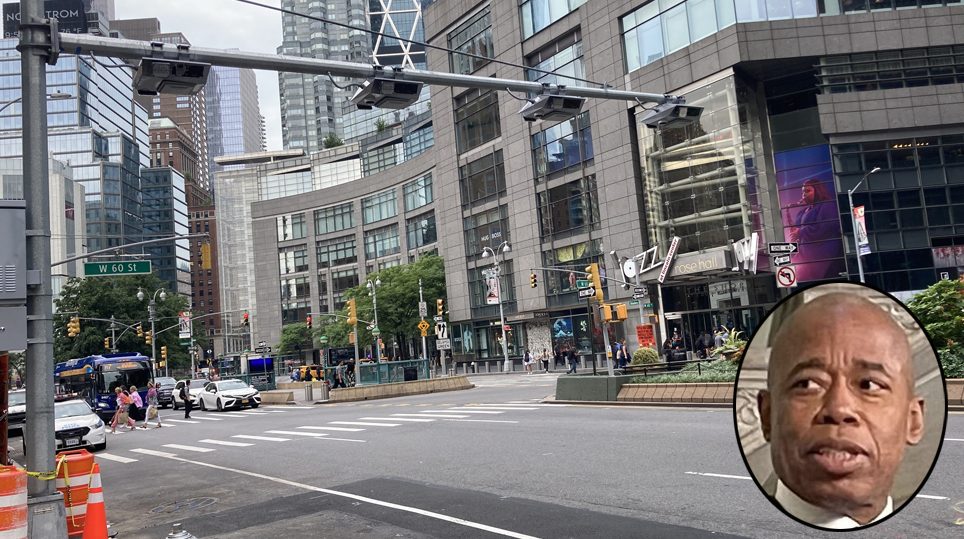With less than two months until the planned launch of congestion pricing, Mayor Adams on Thursday finally unveiled a list of bike, bus and pedestrian projects intended to take advantage of the drop in car traffic expected from the tolls — many of them started under his predecessor Bill de Blasio — that critics said fail to meet the moment.
MTA officials forecast a 17-percent reduction in car traffic from congestion pricing in the toll zone below 60th Street and a 9-percent reduction regionally. Yet Adams has no plans for any new pedestrian-only streets, with benefits to walking New Yorkers limited to sidewalk widenings in Manhattan and the continuation of this mayor and his predecessor's plan to convert Broadway into a "slow street" where bikes and pedestrians ostensibly have priority.
Adams's long-awaited plans to seize the onset of congestion pricing contain a handful of new proposals — including new protected bike lanes on 72nd Street and Sixth, Seventh and Tenth avenues in Manhattan, bus lanes on Church Avenue in Flatbush and a possible busway on 34th Street in Midtown — but all are still in the "community planning phase," without set timelines for completion.
The report, titled "Connecting the Core," contains 47 projects "implemented since 2019," when the state Legislature approved congestion pricing, and 37 "new" projects. Among the 37 "new" projects, 14 were previously announced, six are merely upgrades of existing facilities and eight have long been in the works.
Just 17 had not been announced at all before the report's release.
"Most of this is old news. It's not rising to the challenge of taking advantage of this big one-time historical drop in traffic we're going to get," said Bike New York Advocacy Director Jon Orcutt, who has spent years advocating for the Department of Transportation to capitalize on the "space dividend" of congestion pricing to make more room for pedestrians, cyclists and bus riders.
The report's signature announcement for 34th Street is a re-hash of a project proposed (and killed) during Mayor Michael Bloomberg's third term. And DOT's upcoming expansion of bicycle and pedestrian access on the Queensboro Bridge this summer was first announced back in 2017.
Brooklyn can likely expect a significant reduction in car traffic thanks to congestion pricing, but "Connecting the Core" also includes no new bike lane proposals for any part of Brooklyn. Instead, the report simply touts protected bike lanes proposed under de Blasio on Fourth Avenue, Ashland Place, Meeker Avenue and McGuinness Boulevard.
City Hall's plans to extend or upgrade existing protected bike lanes on Third, Sixth, Seventh and 10th avenues in the congestion zone, meanwhile, hardly depend on the extra space created by the new tolls, according to Orcutt, who served as DOT Policy Director during the Bloomberg and de Blasio administrations.
"They're two years too late to work on a real program, so you get a few good things in there like extending the Third Avenue bike lane. They're finally going to finish the Sixth Avenue bike lane, but [that's] not something that really relied on congestion pricing to happen," Orcutt told Streetsblog. "Almost nothing here is news."
There’s some good here (3rd Ave 🚲 lane extensions, completing 6th Ave bike lane). But overall, releasing a mostly retrospective report weeks before a really momentous transportation policy change is pathetic & embarrassing https://t.co/mB6YlDSvdG
— Jon Orcutt (@jonorcutt) May 2, 2024
DOT's reluctance to make significant changes in Brooklyn likely stems from challenges the agency has faced implementing projects there since Adams took office. Several efforts started under de Blasio — the Underhill Avenue bike boulevard and protected bike lanes on Ashland Place and McGuinness Boulevard — faced significant delays and modifications last year due to opposition from senior Adams adviser Ingrid Lewis-Martin.
DOT must now run all of its work through Lewis-Martin aide Richard Bearak, Streetsblog previously reported. The agency seemingly abandoned efforts to install bus lanes on Flatbush Avenue as a result, though officials still included the project — without a timeline or geographic parameters — in Thursday's report.
Many of the projects included in the report are simply being "explored" or "studied," in the city's words, including bus lanes on Tremont Avenue in the Bronx and on Upper Broadway in Manhattan. Eight of the projects are listed as still in the "community planning phase," leaving them subject to changes that could render them far less effective than initially proposed. The Sixth Avenue bike lanes extension, which local elected officials pointed out in a recent letter was first requested by the local community board in 2017, does not have a timeline.
One of my priorities is getting protected bike lanes and pedestrian safety features on every major corridor in Council District 3. Last year, we were able to win a protected bike lane on Tenth Avenue (to be completed this year). One missing gap is Sixth Avenue, below W9th Street. pic.twitter.com/UbbsCECL0Z
— Erik Bottcher (@ebottcher) May 1, 2024
Advocates have been clawing for the Adams administration to prepare the city's streets for congestion pricing for years. In fact, 10 months have passed since Transportation Alternatives released recommendations for the city — many of them still unheeded.
In particular, the group has called on the city to convert all bus lanes to 24/7 operations, expand discount fares for low-income riders and free fares for students and "expedite" projects planned for so-called environmental justice communities in order to mitigate adverse impacts of auto traffic redirecting around the new tolling zone.
"Today’s announcement is a welcome step in the right direction [but] at the same time, the administration has had years to prepare for this and the announcement needs to go much further," Elizabeth Adams, the group's Deputy Executive Director for Public Affairs, said in a statement.
“Congestion pricing is an opportunity to transform New York City for the better — bringing cleaner air, safer streets, faster public transit, and more space to everyone. This transformation demands real and visionary proposals from our city’s leaders.”
Open Plans, Streetsblog's parent organization, put out its own list of recommendations for the city ahead of congestion pricing that "Connecting the Core" passed on — including reviving de Blasio's dormant plans to transform Fifth Avenue, offering free ferry service the first week of the new toll, pedestrianizing specific neighborhoods and streets outside schools and installing two-way crosstown protect bike lanes up and down Manhattan.
Still, Riders Alliance spokesman Danny Pearlstein welcomed City Hall's vocal endorsement of congestion pricing's benefits to all five boroughs.
"This report reinforces the idea that congestion pricing is going to be good for the entire city. Just as there are opportunities for the core of Manhattan, there are opportunities in the outer boroughs such as on Tremont Avenue in the Bronx and Flatbush Avenue and Church Avenue in Brooklyn," Pearlstein told Streetsblog.
"The devil's in the details," Pearlstein added. "A lot of these projects have been on the board for a long time. We want to see rapid and robust implementation, especially of the items for bus riders. We don't want to see half measures."
And Carl Mahaney of Streetopia UWS welcomed the announcement for a 72nd Street bike lane, which comes weeks after his organization shared a vision for the street that includes prohibiting most car traffic to prioritize bikes, buses and pedestrians.
"The Upper West Side desperately needs a comprehensive micromobility network, and a protected bike lane along West 72nd Street — something that Community Board 7 formally requested nearly four years ago — would just be a start," said Mahaney.
"Our campaign to reimagine West 72nd Street shows the kind of public space and transportation choices New Yorkers can have if we focus less on lane miles and consider our streets holistically from the perspective of those who use them everyday."
The city released "Connecting the Core" via email with no in-person announcement and little fanfare. In a statement sent out by DOT, Adams did not mention congestion pricing and focused entirely on the report's Manhattan elements.
“Reducing traffic and expanding transportation options are key to improving quality of life for New Yorkers and this administration remains focused on enhancing access to Manhattan’s central business district for everyone who lives and visits our city,” Hizzoner's statement said.
"The projects outlined in this report will play a critical role in shaping the future of transit and cycling access on nearly every avenue in Manhattan — delivering safe, reliable, and environmentally-friendly ways to get around the borough.”






